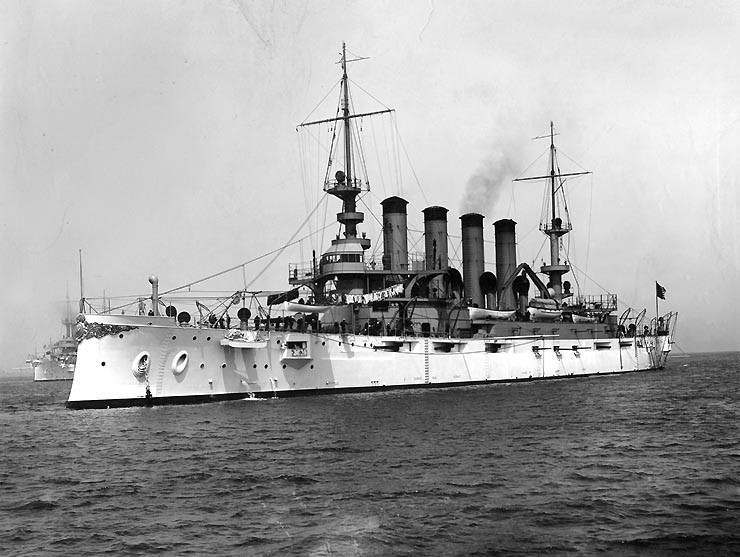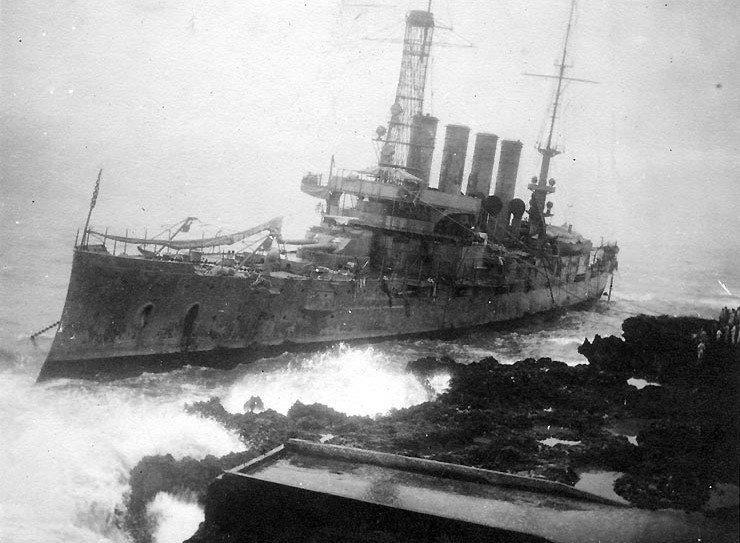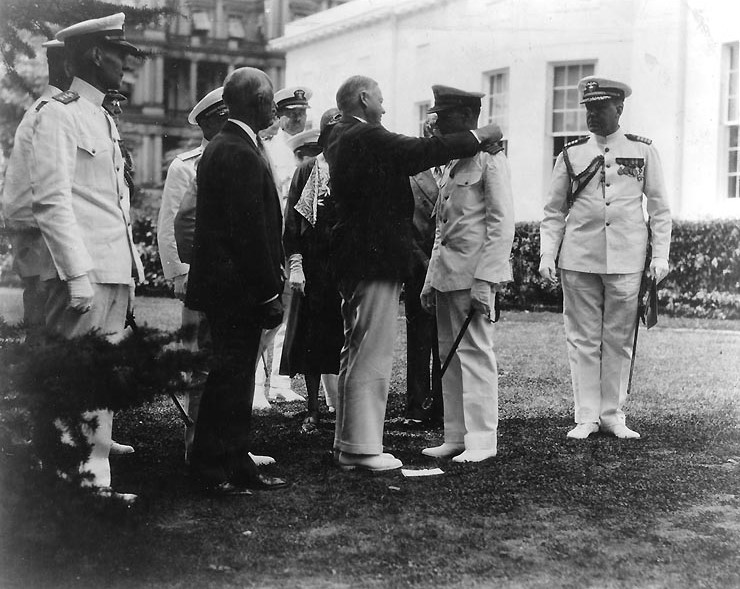|
On Dec. 3, 1904 William Cramp Shipbuilding launched the Armored Cruiser Tennessee. The 14,500 ton ship was 505' long and mounted four 10" guns as her main battery. Her first voyage took her to the Panama Canal as an escort for the USS Louisiana, which carried President Theodore Roosevelt to the Canal Zone to inspect the progress of the construction. She returned to the canal in Nov. 1910 this time Tennessee carried President William H. Taft for his inspection. Between the two trips to the canal Tennessee sailed to Europe and the Pacific to serve with the Pacific Fleet. This she did until 1910 ending her time in the Pacific in Argentina to celebrate 100 years of independence for that country. Returning to the Atlantic Fleet Tennessee was sent to the Mediterranean off Turkey in Nov. 1912 to protect US citizens during the Balkan War. She remained there until May 1913. On May 25, 1916 Tennessee was renamed Memphis to free the name up for the new battleship being built. Memphis was sent to the Dominican Republic arriving at Santo Domingo on July 23, 1916. It was the political strife in the small Republic which was the reason for the U.S. Navy to be dispatched once again to protect Americans. Memphis dropped off the reinforcements for the Marines who were already there and patrolled off the coast. On August 29, 1916 while anchored off Santo Domingo an earthquake shook the bottom of the ocean somewhere in the Caribbean or perhaps further away in the Atlantic, of course this was not felt on the Memphis. Admiral Pond and his party were ashore and the remainder of the ship's crew were busy at their normal routine. At 15:20 the First Officer noticed the sea was changing, alarmed by what they saw at 15:30 Captain Beach ordered the ship to bring up steam and prepare to get underway. This process normally took about forty minuets. It did not take long for the sea to become violent and wave after wave broke around the ship making it difficult to build up steam. The ship rolled from side to side as the waves got worse. Water poured in through the ventilation system and any opening on the ship. It is even said that water came down her funnels. She bottomed out several times even though the depth of the water was some 35'. As the waves rolled out it took most of the water in the area with it, a classic warning. Soon it was seen, a huge wave on the horizon, a tsunami. The gunboat Castine managed to get underway, but the Memphis could not. The tsunami was headed right at the Memphis and the captain could do nothing but pray. The giant wave hit her about 16:30 sending her on to the rocks and killing several crewmen. Others were killed in the engine room from steam pouring out of broken pipes and boilers. The Admiral's launch was sent out, for some unknown reason, during the height of the waves. While I don't know if the Admiral was aboard, 25 of those who were died when the launch sank. Several more sailors died when they tried to reach shore in three small boats which never made it. In total forty-one were killed and over 200 were injured, many seriously. The Memphis was a total loss and was abandoned having her armament and anything else of use stripped in the weeks that followed. The wreck remained there until 1938 when she was scrapped. During the fight to save the Memphis Lt. Claud A Jones, the Engineering Officer, was the man in charge of getting up steam. While the engine room was falling apart around him he remained, even though injured, and continued to try to get her going. When it was clear there was nothing else he could do, he began getting his men out. For his effort and heroism he was awarded the Medal of Honor in 1932. Medal of Honor Citation "For extraordinary heroism in the line of his profession as a senior engineer officer on board the U.S.S. Memphis, at a time when the vessel was suffering total destruction from a hurricane {sic} while anchored off Santo Domingo City, 29 August 1916. Lieutenant Jones did everything possible to get the engines and boilers ready, and if the elements that burst upon the vessel had delayed for a few minutes, the engines would have saved the vessel. With boilers and steam pipes bursting about him in clouds of scalding steam, with thousands of tons of water coming down upon him and in almost total darkness, Lieutenant Jones nobly remained at his post as long as the engines would turn over, exhibiting the most supreme unselfish heroism which inspired the officers and men who were with him. When the boilers exploded, Lieutenant Jones, accompanied by two of his shipmates, rushed into the firerooms and drove the men there out, dragging some, carrying others to the engine room, where there was air to be breathed instead of steam. Lieutenant Jones' action on this occasion was above and beyond the call of duty." |
© 2006 Michael W. Pocock MaritimeQuest.com |
Roll of Honor |
 |
In memory of those who lost their lives in USS Memphis "As long as we embrace them in our memory, their spirit will always be with us" |
Name |
Rate |
||
Anderson, Alphonsus J. |
Fireman 2nd Class |
||
Carlton, William R. |
Fireman 2nd Class |
||
Copius, Walter |
Fireman 2nd Class |
||
Crosier, Lawrence L. |
Fireman 2nd Class |
||
Diehl, William C. |
Coxswain |
||
Dugan, Charles M. |
Fireman 1st Class |
||
Duplissey, Henry A. |
Ordinary Seaman |
||
Frederick, Melvin F. |
Seaman |
||
Gawronski, Peter P. |
Coxswain |
||
Hannon, George A. |
Seaman |
||
Harcourt, Charles |
Seaman |
||
Harrington, James J. |
Fireman 1st Class |
||
Howard, Charles |
Wardroom Steward |
||
Jackson, William E. |
Ordinary Seaman |
||
Kenney, William F. |
Seaman |
||
Lindsey, Ashton C. |
Boatswain's Mate 2nd Class |
||
Lutomski, Walter S. |
Seaman 2nd Class |
||
Major, Fred M. |
Seaman |
||
McDermott, Martin A. |
Seaman |
||
Mullaney, Henry |
Ordinary Seaman |
||
O'Hara, Thomas H. |
Fireman 1st Class |
||
Planck, Walter L. |
Watertender |
||
Porter, Arthur L. |
Watertender |
||
Quinn, Elphard J. |
Watertender |
||
Reynolds, Charles J. |
Ordinary Seaman |
||
Riedel, Herbert E. |
Ordinary Seaman |
||
Rollins, Edgar A. |
Seaman |
||
Rud, George W. |
Chief Machinist's Mate |
||
Rudolph, Albert J. |
Oiler |
||
Schocklin, Jr., Jacob |
Coxswain |
||
Sheehan, John J. |
Fireman 2nd Class |
||
Smith, William B. |
Coxswain |
||
Snell, Raymond G. |
Seaman |
||
St. Clair, Roy |
Ordinary Seaman |
||
Stone, Frank W. |
Chief Machinist's Mate |
||
Taylor, Charles E. |
Fireman 2nd Class |
||
Teshack, Joseph |
Fireman 2nd Class |
||
Thorner, John W. |
Yeoman 2nd Class |
||
Tingle, Roland L. |
Ordinary Seaman |
||
Toepfer, William H. |
Seaman |
||
Townsend, James H. |
Fireman 1st Class |
 |
|
USS Tennessee ACR-10 seen in 1907.
|
 |
USS Memphis ACR-10 aground at Santo Domingo, Dominican Republic. |
 |
1932: Commander Claude A. Jones receiving the Medal of Honor from President Herbert Hoover. |